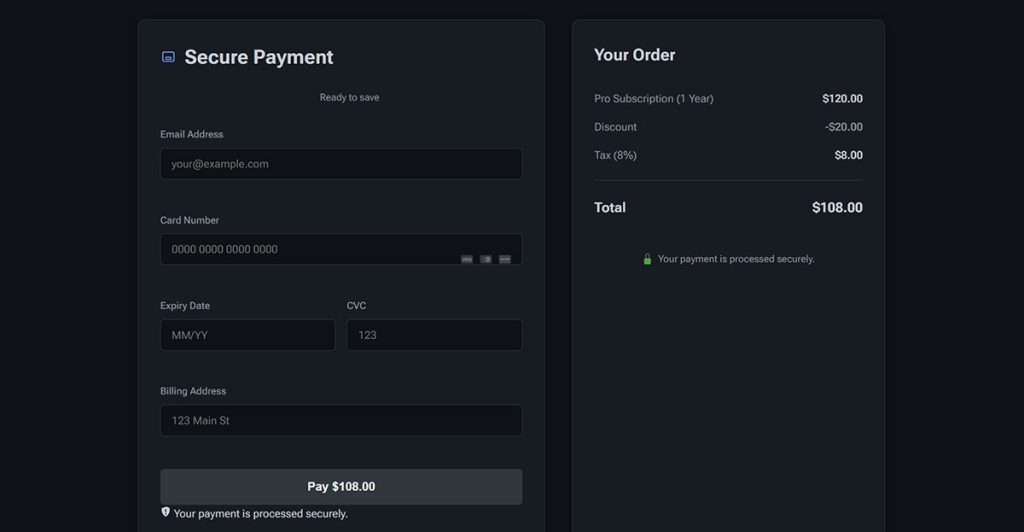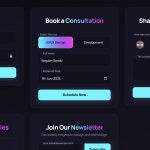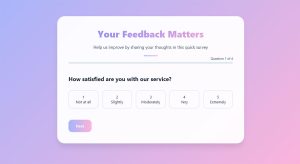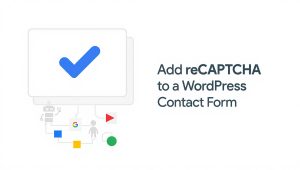Your form abandonment rate is probably killing your conversions right now. Studies show that 81% of users who start filling out forms never finish them, which means you’re losing leads,…
Table of Contents
Seventy percent of online shoppers abandon their carts before completing purchases. That’s roughly $4 trillion in lost sales annually.
Cart abandonment kills ecommerce profits faster than any other conversion problem. Hidden shipping costs, confusing checkout flows, and limited payment options drive customers away at the worst possible moment.
The good news? Effective checkout optimization tips can recover most of these lost sales. Small improvements to payment processing, trust signals, and user experience design create massive revenue increases.
This guide covers proven strategies that boost conversion rates and reduce abandonment. You’ll discover how to streamline checkout flows, implement the right payment methods, build customer trust, and create mobile-friendly experiences that turn browsers into buyers.
Streamlining the Checkout Process
Cart abandonment hits every online store. Studies show 70% of shoppers leave without buying. The fix? Make checkout ridiculously simple.
Reducing Form Fields and Steps

Fewer fields equal more sales. Period.
Every extra field you add creates friction. Ask only for what you absolutely need. Name, email, shipping address, payment info. That’s it.
Single-Page vs Multi-Step Checkout
Single-page works best for simple purchases. Everything’s visible at once. No surprises, no confusion.
Multi-step suits complex orders with lots of options. Break it into logical chunks:
- Shipping information
- Payment details
- Order review
Both approaches work. Pick what fits your product mix.
Smart Defaults and Auto-Fill
Auto-fill functionality saves customers time. Enable browser auto-complete for all fields. Pre-populate shipping as billing address unless they say otherwise.
Smart defaults reduce clicks:
- Set most popular shipping method as default
- Auto-select standard delivery
- Default to guest checkout
Address Validation Tools
Real-time address validation prevents shipping errors. Google Maps API and similar services catch typos instantly.
Wrong addresses cost money. Failed deliveries frustrate customers. Prevention beats correction every time.
Guest Checkout Implementation

Forcing account creation kills conversions.
Let people buy without registering. Offer account creation after purchase when they’re happy, not before when they’re deciding.
Account Creation Friction Removal
Remove registration barriers completely. Studies show guest checkout can boost conversions by 45%.
Post-purchase registration feels different. Customers just received value. They’re more likely to create accounts now.
Social Login Benefits
When you do offer registration, make it easy. Google Pay, Apple Pay, and Facebook login reduce form friction.
One-click registration beats typing passwords. Social logins also provide verified email addresses.
Mobile Checkout Experience
Mobile drives 60% of ecommerce traffic. Your mobile checkout better be perfect.
Thumb-Friendly Design
Mobile users navigate with thumbs. Place buttons where thumbs naturally reach. Make tap targets at least 44 pixels wide.
Responsive design isn’t optional anymore. It’s expected.
Keyboard Optimization
Match keyboard types to field types:
- Numeric keypad for phone numbers
- Email keyboard for email fields
- Standard keyboard for names
Wrong keyboards frustrate mobile users. This small detail makes a big difference.
Touch Gesture Improvements
Enable touch-friendly interactions:
- Swipe to edit cart items
- Pinch to zoom product images
- Long press for quick actions
Touch gestures feel natural on mobile. Desktop interactions feel clunky.
Payment Method Optimization
Payment preferences vary wildly. The more options you offer, the more sales you’ll capture.
Popular Payment Integration
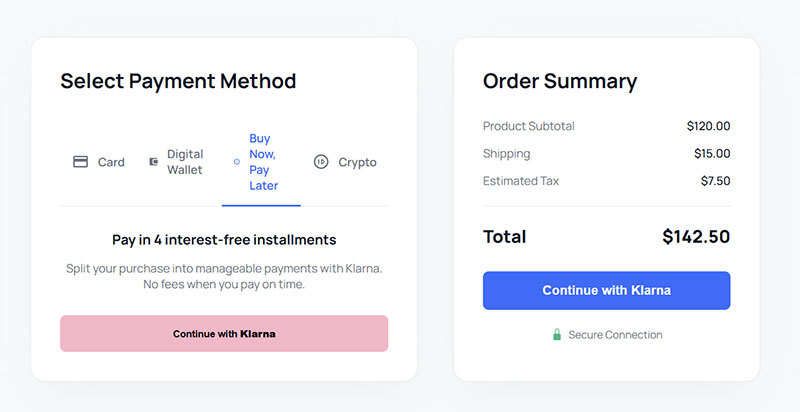
Different customers prefer different payment methods. Covering all bases matters.
Credit and Debit Cards
Still the most popular option. Stripe and PayPal handle most card processing needs.
Display accepted card types clearly. Show security badges prominently. Trust signals matter during payment.
Digital Wallet Implementation
Digital wallets are exploding in popularity. Apple Pay, Google Pay, and Amazon Pay offer one-click purchasing.
These services handle authentication and address info. Customers complete purchases in seconds, not minutes.
Benefits of digital wallets:
- Faster checkout completion
- Higher security standards
- Better mobile experience
- Reduced cart abandonment
Buy Now, Pay Later Services
Klarna, Afterpay, and similar services attract younger shoppers. They prefer spreading payments over time.
BNPL can increase average order values. Customers buy more when payment feels manageable.
Cryptocurrency Payments
Crypto payments appeal to tech-savvy customers. Bitcoin, Ethereum, and stablecoins gain mainstream acceptance.
Crypto transactions offer privacy and security. Processing fees can be lower than traditional cards.
Local Payment Methods
International customers need local options. Europeans love SEPA transfers. Asians prefer Alipay and WeChat Pay.
Research your target markets. Local payment methods often have higher conversion rates than international cards.
Payment Security and Trust

Security fears kill conversions. Combat them aggressively.
SSL Certificate Display
SSL certificates encrypt payment data. Display your security badge prominently near payment fields.
Browser security indicators help too. That green padlock icon builds confidence.
Security Badge Placement
Place trust badges where customers see them during payment:
- Next to credit card fields
- Above the submit button
- In the footer of checkout pages
VeriSign, Norton Secured, and McAfee Secure badges work well.
PCI Compliance Indicators
PCI compliance protects payment data. Mention your compliance status on checkout pages.
Most customers don’t understand PCI details. They just need to know you follow security standards.
Fraud Protection Messaging
Explain your fraud protection without scaring customers. Simple messages work:
- “Your payment is protected”
- “Secure 256-bit encryption”
- “Fraud monitoring active”
Payment Processing Speed
Slow payments frustrate customers. Speed builds confidence.
Real-Time Validation
Validate payment info as customers type. Credit card number formats, expiration dates, CVV codes.
Instant feedback prevents submission errors. Red text for problems, green for success.
Background Processing
Process payments in the background when possible. Show progress indicators during processing.
Never leave customers staring at blank screens. Animation indicates progress.
Error Handling and Recovery
Payment failures happen. Handle them gracefully:
- Clear error messages in plain English
- Specific instructions for fixing problems
- Alternative payment method suggestions
- Customer support contact info
Transaction Status Communication
Keep customers informed throughout payment processing:
- “Processing payment…”
- “Verifying details…”
- “Payment confirmed!”
Clear status updates reduce anxiety. Customers know something’s happening.
Trust Building Elements
Customer trust drives conversion rates. Without it, even perfect checkout flows fail.
Security Badges and Certifications
Trust signals calm nervous shoppers. Place them strategically throughout your checkout.
Third-Party Security Verification
Security badges from recognized providers build instant credibility. Customers recognize these symbols and feel safer proceeding with purchases.
Display badges prominently:
- Near payment fields
- Above the “Complete Order” button
- In checkout page headers
Popular trust badges include Norton Secured, McAfee Secure, and VeriSign. Choose badges your customers actually recognize.
Industry Compliance Displays
PCI compliance isn’t just required – it’s a selling point. Mention compliance status clearly without technical jargon.
Simple compliance messages work best:
- “PCI DSS Compliant”
- “Bank-level security”
- “Industry standard protection”
Customer Data Protection Messaging
GDPR compliance and privacy protection matter more than ever. Address concerns upfront.
Brief privacy statements near data collection fields reassure customers. Link to full privacy policies for detailed information.
Money-Back Guarantee Prominence
Guarantees remove purchase risk. Display them boldly during checkout.
Clear guarantee terms work better than vague promises. “30-day money-back guarantee” beats “satisfaction guaranteed.”
Customer Reviews and Social Proof
Social proof influences buying decisions. Use it strategically during checkout.
Recent Purchase Notifications
Real-time purchase notifications create urgency and social validation. “Sarah from Chicago just bought this item” feels authentic when it’s true.
Keep notifications relevant to the current product. Generic messages feel fake and hurt credibility.
Customer Testimonial Integration
Include brief testimonials near product summaries in checkout. Keep them short and specific.
Good testimonials mention:
- Specific benefits received
- Quick delivery experience
- Easy return process
Star Ratings and Review Snippets
Display average ratings and review counts prominently. 4.2 stars with 847 reviews beats 5 stars with 3 reviews.
Include recent review snippets that address common concerns about shipping, quality, or customer service.
Purchase Volume Indicators
Show purchase popularity without being pushy. “147 people bought this today” works better than “Only 3 left in stock!”
Volume indicators work especially well for new products without many reviews yet.
Contact Information and Support
Easy access to human help builds massive trust. Don’t hide your contact options.
Live Chat Availability
Live chat support during checkout reduces abandonment dramatically. Customers get instant answers to last-minute questions.
Display chat availability clearly:
- “Live help available now”
- “Questions? Chat with us”
- “Need help? We’re online”
Phone Number Visibility
Real phone numbers signal legitimate businesses. Display yours prominently, even if most customers won’t call.
Include business hours with phone numbers. International numbers help global customers feel welcome.
Business Address and Credentials
Physical addresses build trust, especially for expensive purchases. Include your business address in checkout page footers.
Business credentials like BBB ratings or chamber of commerce memberships add credibility.
Customer Service Hours Display
Clear service hours set proper expectations. Customers appreciate knowing when help is available.
Multiple time zones matter for international businesses. Consider “24/7 email support” if phone hours are limited.
Shipping and Delivery Optimization
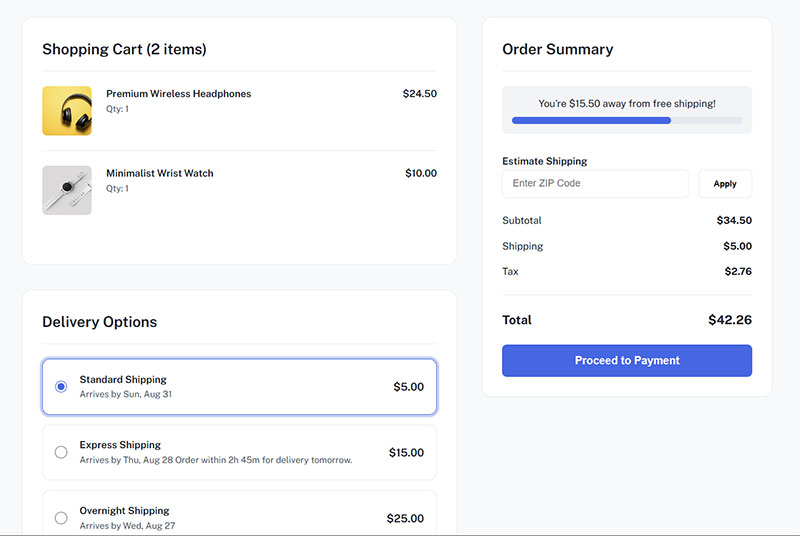
Shipping cost transparency makes or breaks checkout completion. Hidden fees are conversion killers.
Transparent Shipping Costs
Surprise shipping charges cause 61% of cart abandonments. Eliminate surprises completely.
Early Cost Disclosure Strategies
Show shipping costs before checkout begins. Product pages, cart pages, everywhere customers see prices.
Shipping calculators on product pages let customers estimate total costs early. No surprises means higher conversion rates.
Free Shipping Threshold Implementation
Free shipping thresholds increase average order values. “Free shipping on orders over $50” encourages larger purchases.
Make thresholds achievable but profitable. Analyze your average order value and set thresholds slightly above it.
Popular threshold strategies:
- Round numbers ($25, $50, $75)
- Just above average order value
- Seasonal adjustments for holidays
Shipping Calculator Integration
Real-time shipping calculations prevent checkout abandonment. Integrate with UPS, FedEx, and USPS APIs for accurate rates.
Let customers compare shipping options easily. Some prefer speed, others prefer savings.
Multiple Delivery Option Presentation
Offer shipping choices without overwhelming customers. Three options work well:
- Standard (5-7 days)
- Express (2-3 days)
- Overnight
Show delivery dates, not just timeframes. “Arrives Tuesday, March 15” beats “2-3 business days.”
Delivery Date Communication
Clear delivery expectations reduce customer service inquiries and build satisfaction.
Real-Time Delivery Estimates
Calculate delivery dates based on current inventory and shipping location. Real estimates beat generic ranges.
Factor in processing time, shipping time, and weekends. Accuracy builds trust for future purchases.
Express Shipping Options
Rush shipping generates additional revenue while serving impatient customers. Price it to cover costs plus profit margin.
Clearly communicate express cutoff times. “Order by 2 PM for next-day delivery” sets clear expectations.
Delivery Tracking Setup
Tracking information reduces customer anxiety. Send tracking numbers immediately when items ship.
Integrate tracking into customer accounts when possible. Self-service tracking reduces support tickets.
Holiday and Weekend Considerations
Holiday shipping gets complicated fast. Communicate delays and cutoff dates clearly during busy seasons.
Weekend delivery appeals to working customers. Amazon and others offer weekend options in many areas.
Return Policy Clarity
Easy returns increase initial purchase confidence. Make your policy clear and generous.
Easy Return Process Explanation
Simple return processes encourage purchases. “Print a prepaid label, drop off anywhere” beats complicated procedures.
Step-by-step return instructions reduce customer service calls. Visual guides work even better.
Return Window Communication
Clear return timeframes prevent confusion. “30 days from delivery” is clearer than “30 days from purchase.”
Extended holiday return windows encourage gift purchases. Many retailers extend returns through January.
Refund Timeline Expectations
Tell customers exactly when they’ll see refunds. “5-7 business days after we receive your return” sets proper expectations.
Different payment methods have different refund speeds. Credit cards process faster than bank transfers.
Return Shipping Responsibility
Clarify who pays return shipping upfront. Free return shipping increases sales but impacts margins.
Consider free returns for defective items, paid returns for size exchanges. Balance customer satisfaction with profitability.
Error Prevention and Recovery
Checkout errors frustrate customers and kill sales. Error handling makes the difference between abandoned carts and completed purchases.
Form Validation Techniques
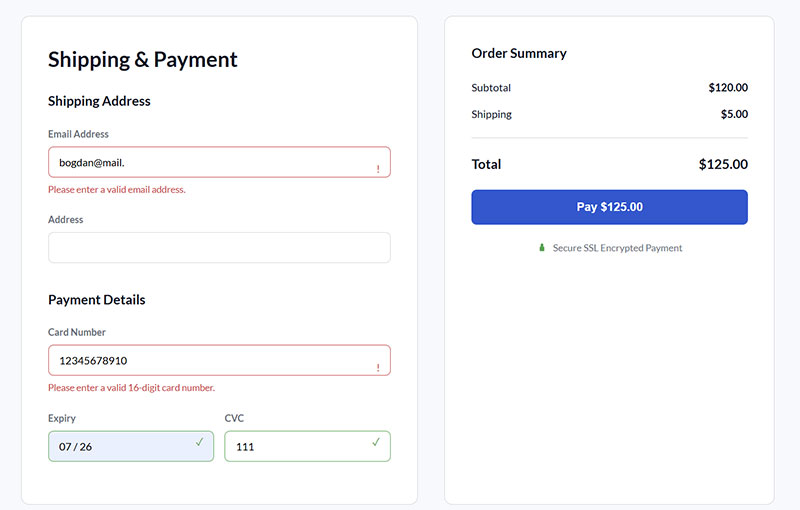
Smart validation catches problems before they become failures.
Real-Time Field Validation
Validate data as customers type. Red indicators for problems, green for correct entries.
Form validation works best when it’s immediate:
- Email format checking
- Credit card number verification
- Required field highlighting
Don’t wait for form submission to catch obvious errors.
Clear Error Messaging
Technical error messages confuse customers. Use plain English instead.
Bad: “Input validation failed for field cc_num” Good: “Please check your credit card number”
Error messages should tell customers exactly what to fix and how.
Inline Correction Suggestions
Help customers fix errors without guessing. Suggest corrections when possible.
Common suggestions:
- “Did you mean gmail.com instead of gmai.com?”
- “Credit card numbers are usually 16 digits”
- “ZIP codes need 5 digits”
Progress Saving Capabilities
Save customer progress automatically. Nobody wants to re-enter everything after an error.
Auto-save works especially well for multi-step forms and complex checkout processes.
Technical Error Handling
Technical problems happen. Handle them gracefully.
Payment Failure Recovery
Payment failures need immediate, clear recovery options. Don’t just say “payment failed.”
Provide specific next steps:
- Try a different card
- Check card details
- Contact your bank
- Use alternative payment methods
Payment processing errors often have simple fixes. Guide customers through solutions.
Session Timeout Management
Long checkout sessions sometimes timeout. Warn customers before losing their data.
Session timeout warnings work well:
- “Your session expires in 5 minutes”
- “Click here to extend your session”
- “Save your progress now”
Browser Compatibility Issues
Not everyone uses Chrome. Test checkout flows across browsers and devices.
Common compatibility problems:
- Safari payment form issues
- Mobile keyboard problems
- Older browser limitations
Network Connectivity Problems
Slow connections cause payment failures. Build in retry mechanisms and clear messaging.
Show connection status when possible. “Slow connection detected – this may take longer than usual.”
User-Friendly Error Messages
Generic errors frustrate customers. Specific, helpful messages build confidence.
Plain Language Explanations
Skip technical jargon completely. Write like you’re helping a friend.
Technical: “SSL handshake failed” Friendly: “Connection problem – please try again”
Actionable Correction Steps
Every error message needs a clear next step. Tell customers exactly what to do.
Helpful error components:
- What went wrong
- Why it happened (if helpful)
- Exactly how to fix it
- Alternative options
Alternative Solution Offerings
When one payment method fails, suggest others immediately. Don’t make customers figure it out.
Smart alternatives:
- PayPal when cards fail
- Google Pay for mobile users
- Bank transfer for large orders
Support Contact Integration
Include support contact info with complex errors. Some problems need human help.
Make it easy: “Still having trouble? Chat with us or call 1-800-555-0123”
Cart and Order Summary Enhancement
Clear order summaries prevent confusion and build confidence. Customers need to know exactly what they’re buying.
Clear Product Information Display
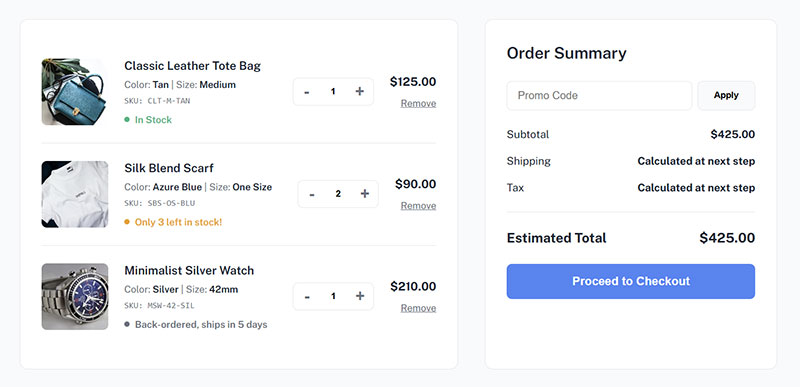
Product details in checkout should match product pages exactly.
Item Images and Descriptions
Show product images in cart summaries. Visual confirmation prevents ordering mistakes.
Include key details:
- Product name
- Size/color selections
- Model numbers
- Brief descriptions
Inventory status updates prevent disappointment. “2 left in stock” creates urgency without pressure.
Quantity Modification Ease
Let customers change quantities without leaving checkout. Plus/minus buttons work better than typing.
Make quantity changes obvious:
- Clear increase/decrease buttons
- Instant price updates
- Easy item removal
Size, Color, and Variant Clarity
Show selected variants prominently. “Large, Blue, Cotton” prevents confusion about what’s being ordered.
Variant changes during checkout should be possible but not encourage cart abandonment.
Inventory Status Updates
Real-time inventory prevents overselling disappointments. Show current availability clearly.
Helpful inventory messages:
- “In stock – ships today”
- “2 remaining at this price”
- “Back-ordered – ships in 3 days”
Pricing Transparency
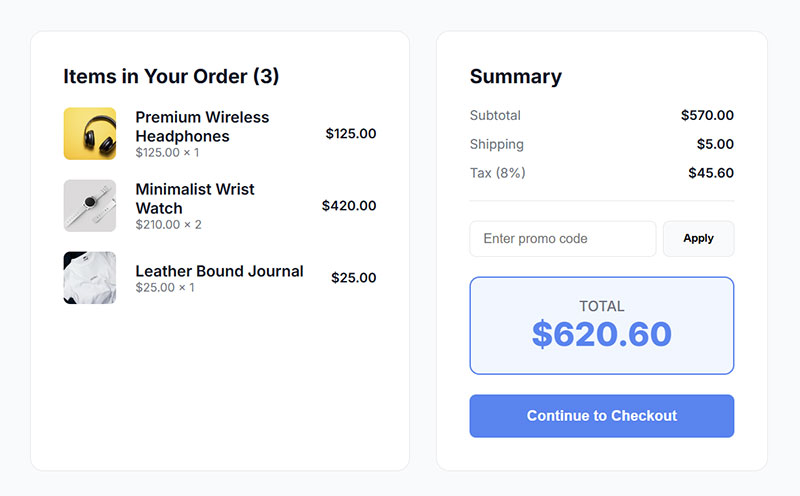
Pricing transparency builds trust and reduces cart abandonment.
Item Price Breakdown
Show individual item prices, quantities, and subtotals clearly. Math errors destroy trust.
Price display best practices:
- Individual item costs
- Quantity × price calculations
- Running subtotals
- Clear total pricing
Tax Calculation Display
Show tax calculations separately. Customers want to understand the total cost breakdown.
Tax display varies by location but should always be clear and accurate.
Discount Code Application
Make discount codes easy to apply and remove. Show savings prominently when codes work.
Promo code functionality should:
- Work with single clicks
- Show exact savings amounts
- Allow easy removal
- Display clearly in totals
Final Total Prominence
The final total should be the biggest, boldest number on the page. No confusion about the actual cost.
Highlight final pricing with:
- Larger font sizes
- Bold formatting
- Border emphasis
- Strategic positioning
Upselling and Cross-selling Integration
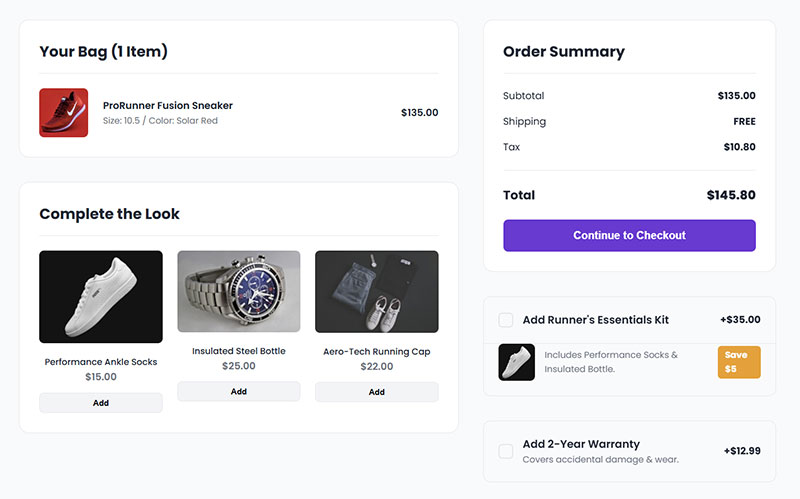
Smart product suggestions increase order values without annoying customers.
Related Product Suggestions
Show relevant additions without being pushy. “Customers also bought” works better than “You need this too.”
Effective suggestion placement:
- Below main cart items
- During shipping selection
- After payment but before confirmation
Bundle Offer Presentations
Bundle discounts appeal to value-conscious shoppers. Show clear savings amounts.
Good bundle offers:
- Logical product combinations
- Meaningful discounts
- Easy acceptance/rejection
- Clear value propositions
Warranty and Service Additions
Extended warranties and services generate profit but must add real value.
Present service options clearly:
- What’s covered
- How long coverage lasts
- Exact costs
- Easy opt-out options
Non-Intrusive Recommendation Placement
Suggestions should enhance, not interrupt, the checkout flow. Subtle placement works better than popup offers.
Smart suggestion timing:
- After address entry
- During shipping selection
- Before final confirmation
- Never during payment entry
Loading Speed and Performance
Page speed directly impacts conversions. Every extra second costs sales.
Page Load Time Optimization
Fast checkout pages convert better. Loading speed improvements show immediate results.
Image Compression Techniques
Large images slow checkout pages. Compress product images without losing quality.
Effective compression methods:
- WebP format for modern browsers
- JPEG optimization for photos
- PNG compression for graphics
- Lazy loading for below-fold images
Product thumbnails should load in under 1 second.
Script Loading Prioritization
Load critical checkout scripts first. Payment processing needs priority over analytics.
Script loading order:
- Payment gateway scripts
- Form validation code
- Security verification
- Analytics and tracking last
Defer non-essential scripts until after page interaction.
Content Delivery Network Usage
CDNs reduce latency globally. Shopify, BigCommerce, and other platforms include CDN support.
CDN benefits:
- Faster image delivery
- Reduced server load
- Better global performance
- Automatic optimization
Browser Caching Strategies
Cache static resources aggressively. Returning customers shouldn’t re-download everything.
Cache these elements:
- Product images
- CSS stylesheets
- JavaScript files
- Brand logos
Set appropriate cache headers for different content types.
Progress Indicators and Feedback
Users need feedback during slow operations. Silence creates anxiety.
Loading Animation Implementation
Show progress during payment processing. Stripe and PayPal provide built-in indicators.
Effective loading indicators:
- Spinning wheels for quick operations
- Progress bars for multi-step processes
- Percentage completion when possible
- “Processing…” text for clarity
Step Completion Visualization
Multi-step checkouts need clear progress indicators. Customers want to know their position.
Visual progress elements:
- Step numbers (1 of 3)
- Progress bars
- Completed step checkmarks
- Current step highlighting
Time Estimate Communication
Long processes need time estimates. “This will take 2-3 minutes” sets expectations.
Accurate estimates reduce abandonment. Under-promise and over-deliver on timing.
Background Processing Indicators
Show when systems are working. “Verifying payment details…” keeps customers informed.
Processing messages should be:
- Specific about current action
- Reassuring about security
- Honest about timeframes
Performance Monitoring Tools
Track checkout performance continuously. Problems often develop gradually.
Speed Testing Implementation
Regular speed tests catch performance degradation. Test from multiple locations and devices.
Test checkout flows weekly, not just homepage speed.
User Experience Tracking
Monitor real user interactions. Google Analytics and Hotjar show actual performance.
Track these metrics:
- Page load times
- Time to interactive
- First contentful paint
- Cumulative layout shift
Bottleneck Identification Methods
Find performance problems systematically. Database queries often cause checkout slowdowns.
Common bottlenecks:
- Slow payment gateway responses
- Database query optimization needed
- Large image files
- Unoptimized JavaScript code
Performance Alert Systems
Automated alerts catch problems before customers complain. Set thresholds for critical metrics.
Alert triggers:
- Page load time exceeds 3 seconds
- Payment processing takes over 10 seconds
- Error rates spike above 2%
- Server response time degrades
Testing and Continuous Improvement
Checkout optimization never ends. Conversion tracking reveals improvement opportunities.
A/B Testing Strategies
Test one element at a time. Multiple changes make results impossible to interpret.
Checkout Flow Variations
Test different checkout approaches with real traffic. Single-page vs multi-step comparisons reveal preferences.
Flow testing ideas:
- Guest checkout prominence
- Payment method ordering
- Form field arrangements
- Security badge placement
Run tests for statistical significance, typically 2-4 weeks.
Button Color and Text Testing
Small changes create big results. “Complete Order” vs “Buy Now” can shift conversions.
Button test variables:
- Color psychology (green vs blue)
- Text urgency (“Order Now” vs “Complete Purchase”)
- Size and positioning
- Contrast and visibility
Form Layout Experiments
Form design impacts completion rates. Test field arrangements and validation approaches.
Layout variations:
- Single column vs two column
- Inline validation vs end-of-form
- Required field indicators
- Progress saving features
Form validation best practices vary by audience and product type.
Payment Option Arrangements
Payment method order affects usage. Most popular options should appear first.
Test these arrangements:
- Credit cards vs digital wallets
- Buy now, pay later prominence
- Guest vs account creation
- Express checkout positioning
User Behavior Analysis
Understand how customers actually use your checkout. Data beats assumptions.
Heatmap Implementation
Hotjar and similar tools show where customers click and scroll. Heatmaps reveal usability problems.
Heatmap insights:
- Ignored trust badges
- Confusing navigation elements
- Mobile vs desktop differences
- Form field difficulties
Click Tracking Setup
Track every click during checkout. Google Analytics events show user paths.
Track these interactions:
- Payment method selections
- Shipping option choices
- Promo code attempts
- Help link usage
Scroll Depth Measurement
Monitor how far customers scroll. Important elements below the fold get missed.
Scroll tracking reveals:
- Mobile viewport issues
- Form length problems
- Trust signal placement
- Call-to-action visibility
Exit Point Identification
Find exactly where customers abandon checkout. Exit intent data guides optimization priorities.
Common exit points:
- Shipping cost revelation
- Account creation requirements
- Payment method selection
- Final confirmation step
Feedback Collection Methods
Customer insights drive meaningful improvements. Ask the right questions at the right time.
Post-Purchase Surveys
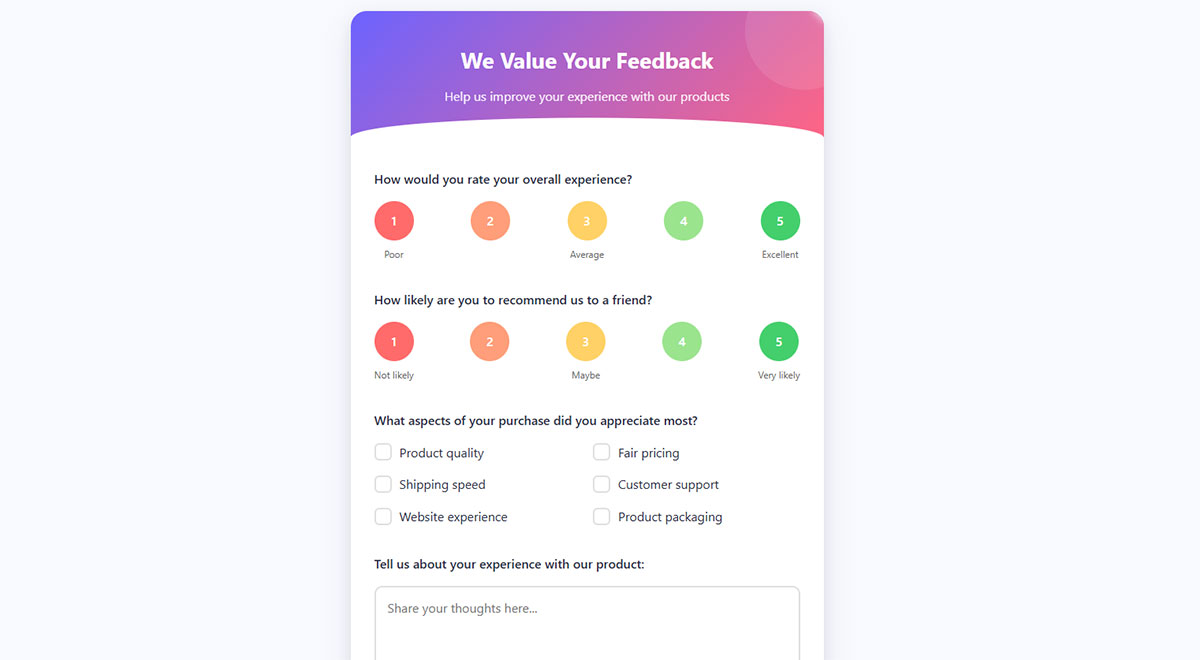
Happy customers provide honest feedback. Survey timing matters – too early misses experience, too late reduces response.
Post-purchase survey questions should cover:
- Checkout difficulty rating
- Preferred payment methods
- Trust signal effectiveness
- Mobile experience quality
Keep surveys under 5 questions for better completion rates.
Exit Intent Questionnaires
Catch abandoning visitors with quick surveys. One question works better than long forms.
Exit survey questions:
- “What prevented you from completing your purchase?”
- “How can we improve checkout?”
- “What payment method would you prefer?”
Exit-intent forms can recover some abandonments while gathering data.
Customer Interview Programs
Phone interviews provide deep insights. Schedule calls with recent customers and abandoners.
Interview topics:
- Checkout pain points
- Competitor comparisons
- Mobile experience feedback
- Trust and security concerns
Support Ticket Analysis
Customer service tickets reveal recurring problems. Categorize and prioritize based on frequency.
Common ticket themes:
- Payment processing errors
- Shipping confusion
- Return policy questions
- Account creation issues
Address the most frequent problems first for maximum impact.
FAQ on Checkout Optimization Tips
What’s the biggest cause of cart abandonment?
Unexpected shipping costs cause 61% of abandonments. Hidden fees destroy trust instantly. Display all costs upfront, including taxes and delivery charges. Free shipping thresholds encourage larger orders while covering costs.
Should I offer guest checkout or require account creation?
Always offer guest checkout. Forced registration kills conversions by 45%. Let customers buy first, then suggest account creation post-purchase when they’re satisfied. Social login options reduce friction for willing registrants.
How many payment methods should I offer?
Offer 3-5 popular options minimum. Include credit cards, PayPal, and digital wallets like Apple Pay. Add buy now, pay later services for younger demographics. More options equal higher conversion rates.
What’s the ideal checkout page loading speed?
Under 3 seconds maximum. Every additional second reduces conversions by 7%. Loading speed directly impacts revenue. Optimize images, use CDNs, and prioritize payment processing scripts over analytics tracking.
How important are security badges and trust signals?
Critical for conversion rates. Display SSL certificates, Norton Secured, or VeriSign badges prominently near payment fields. Trust signals reduce purchase anxiety and increase completion rates significantly.
Should I use single-page or multi-step checkout?
Depends on complexity. Single-page works for simple purchases with minimal options. Multi-step forms suit complex orders with shipping choices. Test both approaches with your specific audience and products.
How can I reduce checkout form abandonment?
Minimize required fields to essentials only. Enable auto-fill functionality and real-time validation. Show progress indicators and save customer data automatically. Clear error messages guide corrections effectively.
What mobile checkout optimizations matter most?
Thumb-friendly design and appropriate keyboards. Make buttons 44+ pixels wide, use numeric keypads for phone numbers, and enable one-handed operation. Mobile drives 60% of traffic.
How do I handle payment processing errors gracefully?
Provide specific, actionable error messages in plain English. Suggest alternative payment methods immediately. Include customer support contact information. Never leave customers guessing about next steps.
What metrics should I track for checkout optimization?
Monitor cart abandonment rates, conversion by checkout step, mobile vs desktop performance, and payment method usage. Track exit points and loading times. Google Analytics provides essential checkout funnel data.
Conclusion
Implementing these checkout optimization tips transforms abandoned carts into completed sales. Small changes to payment processing, security displays, and mobile experiences create massive revenue increases.
User experience design matters more than flashy features. Streamlined forms, transparent pricing, and multiple payment options like Stripe and Google Pay reduce friction at critical decision points.
Testing drives real improvements. Use Google Analytics to track abandonment points, A/B test button colors and form layouts, and monitor mobile performance continuously. Conversion rate optimization requires ongoing attention, not one-time fixes.
Start with the biggest problems first. Fix shipping cost surprises, add SSL certificates prominently, and enable guest checkout options. These changes often double conversion rates immediately.
Your ecommerce conversion improvements begin today. Pick three strategies from this guide and implement them this week. Your bottom line will thank you.
